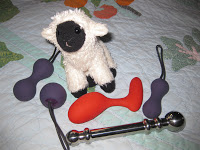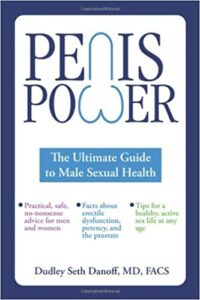Posts Tagged ‘medical challenges’
Kegel Magic: Pelvic Floor Shape-Up For Better Sex
 |
| Diagram from Wikipedia |
January is “shape-up” month, with every lifestyle magazine and website proclaiming a new exercise program.
I’ve got a shape-up program for you, too, and though it’s a muscle workout, you won’t see the results in the mirror or show them off to your friends — except for intimate friends — and then the results will be felt, not seen.
This workout strengthens the muscles of your pelvic floor — the “PC” (pubococcygeus) muscles that run along the pelvic floor and surround the entire vagina. These are the muscles that contract during orgasm.
Regular pelvic floor workouts, AKA Kegel exercises, lead to more enjoyable sex: easier arousal, stronger orgasms, more pleasure. If that’s not enough, strengthening the pelvic floor muscles also protects against urinary incontinence. (Ah, now I have your attention!)
You’ve been told, “Do your Kegels,” but you haven’t been told how to do them most effectively. Here are step-by-step instructions for your pelvic floor workout, thanks to Myrtle Wilhite, MD, MS and staff of A Woman’s Touch Sexuality Resource Center in Madison, Wisconsin:
Step-by-Step Kegels1. Lie down on your back in a comfortable place with your knees bent. Lying down takes the weight off your pelvic floor and leads to earlier success. Have your tool (if you are using one) and lubricant with you.
- If you’re using a tool, coat it with lubricant and insert it into your vagina until it comfortably slips into place just behind the pubic bone. You can’t push it in too far; it cannot get lost inside of you.
- If you’re using your finger(s), wash your hands first, then coat your finger(s) with lubricant. Next, insert your finger(s) about 2 inches into your vagina.
- You can also practice Kegels with nothing at all inside your vagina, or a hand placed on your perineum, to feel the muscle contract from the outside.
2. Contract your pelvic floor muscles. It will feel like you’re pulling up and in toward your belly button. Don’t push out, unless specifically advised by a health care provider. If you’re using a tool, you should feel it rise a bit. If you’re using your finger, you should feel a gentle tightening around the finger. Try to keep your leg, buttock, and abdominal muscles relaxed, and remember to breathe normally throughout the exercise.
3. Hold the lift for a count of 5. If you’re using a tool, you can add resistance by pulling gently on it as you continue using your muscles to pull the tool inward and upward. Remember to breathe!
4. Relax your muscles.
5. IMPORTANT: After each contraction, take a deep belly breath. Inhale deeply and gently blow out the air while you relax your pelvis completely. This deep relaxation is just as important as the other steps, because the deep belly breath relaxes the muscles that are not under your conscious control.
For much more about Kegels from A Woman’s Touch, click here.
The deep relaxation phase is often omitted when we’re told how to do our Kegels, but they’re as important to practice as the contraction. Many women of our age, especially after a period of celibacy, experience what feels like tightening or shrinking of the vaginal opening because the muscles don’t fully release. This can interfere with our enjoyment of penetrative sex.
“Pay equal attention to the contraction and the relaxation of the muscles that surround the vagina in particular,” says sex educator and counselor Ellen Barnard, MSSW, co-owner of A Woman’s Touch. “Otherwise you may find that these muscles are stiff and inflexible, which will also get in the way of comfortable penetration when you are ready to have it.”
You can practice with your own fingers, a partner’s fingers or penis (fun for both of you!), or a sex product designed for vaginal penetration (that’s the “tool” mentioned above) such as a dildo, dilator, or a special Kegel exerciser.
You can also practice your Kegels without tools or fingers, even on the go: standing in the grocery line, driving, walking, working at your desk, during your Pilates, yoga, or dance class. If you’re doing them in public, be sure you’ve mastered the part about not contracting your buttocks, or anyone standing behind you will see what you’re doing!
Although I’ve directed this article to women, Kegels are also important for men. These muscles located in the perineum, the area between the scrotum and the anus, contract during a man’s orgasm. Kegels can make sex more pleasurable for men with age-related, less intense orgasms.
“By strengthening the muscles of the perineum, you will pump more blood to this vital area, achieve greater ejaculatory control, and increase the intensity of your orgasms,” says urologist Dudley S. Danoff, MD, FACS, author of Penis Power: The Ultimate Guide to Male Sexual Health. (Read my interview with Dr. Danoff here.)
Kegels are recommended for all ages, and they’re especially important for Boomers now and through our later years.
Kegels can be fun as well as useful. Though there’s nothing sexual about the pelvic floor exercises per se, there’s nothing to stop you from pleasuring yourself or your partner while you do them, or right afterwards!
(This post first appeared 12/28/12 on the Post50 channel of The Huffington Post here.)
Please read the companion piece to this one: Kegel Exercise “Tools” for Better Sex to learn about cool tools that will make your Kegels lots of fun.
Penis Power: Interview with Dudley Danoff
Urologist Dudley S. Danoff, MD, FACS, is the author of Penis Power: The Ultimate Guide to Male Sexual Health (Del Monaco Press, 2011). It’s an upbeat and even entertaining guide to the complexities, myths, facts, and vagaries of owning a penis (or, in my case, liking penises and being endlessly fascinated by them). Dr. Danoff covers how they work and what’s going on when they don’t work—psychologically as well as physiologically.
My male readers often write me with age-related questions about their penises: what’s a “normal” change with age vs. what’s a medical problem, how they can deal with erection difficulties, how to negotiate new needs and issues with a partner. “We are tragically ill-informed about the penis,” says Dr. Danoff, and he aims to change that.
Although this book is not specifically aimed at our age group, all of it applies to us, and I guarantee you’ll say, “I didn’t know that” several times as you read, even if you’ve owned a penis for 50, 60, or 70 years.
I invited Dr. Danoff to answer questions that specifically address men age 60+ and the women in their lives. I welcome your comments.
Q: What is your big message to our older men?
A: Sex is good for you. It maintains overall physical strength and cardiovascular health, and most of all, it keeps you invigorated. A man’s penis is there to serve him from puberty to old age.
Q: What are the most common misunderstandings that men age 60+ have about their penises or about their sexuality in general? What do you wish all men knew as they aged?
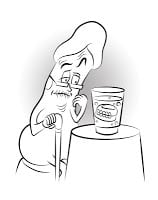 A: By far, the most frequent complaint I hear from men is that they do not have the same level of sexual desire they used to have. It takes longer to get an erection, it takes longer to ejaculate, it takes longer to get aroused again after they make love, and their erections are not as firm. These conditions are all predictable changes that occur as men get older.
A: By far, the most frequent complaint I hear from men is that they do not have the same level of sexual desire they used to have. It takes longer to get an erection, it takes longer to ejaculate, it takes longer to get aroused again after they make love, and their erections are not as firm. These conditions are all predictable changes that occur as men get older.
Attitude is the key to penis longevity. My super-potent patients tell me that sex gives them as much joy at 70 as it did at 20. Some say the sex is even better! Equal pleasure can be obtained from occasional, prolonged intercourse with one orgasm as with frequent, rapid intercourse with multiple orgasms.
All men, as they age, deserve active, healthy sex lives as long as they remain physically fit. Do not expect to do at 60 what you did at 40. Adjust your sexual activities as your body changes, just as you adjust other activities. Look upon the adjustment as both a new challenge and a new opportunity.
As you age, learn to use your mind and imagination to make up in creativity what you may lack in physical strength. As long as you are able to breathe, move your extremities, maintain relative control over your bodily functions, remain alert enough to identify the date and day of the week, and sustain a positive mental outlook, you can continue to exercise your penis power indefinitely.
Q: What would you say to many men age 60+ who tell me that they don’t get good information or direction from their urologists when they report undependable or nonexistent erections? They are commonly told, “Well, you’re older now,” or “It’s ED,” without a medical workup to see whether some underlying condition is causing the ED.
A: Find another urologist who is knowledgeable about erectile dysfunction and is willing and able to thoroughly evaluate you. A comprehensive evaluation, including a full cardiovascular evaluation, by a qualified urologist is essential. Endocrine issues, such as low testosterone or unrecognized diabetes, can then be treated, and erectile dysfunction will improve. Knowledge is power. There are many treatments on the urologic menu for erectile dysfunction, but first you need a proper diagnosis to identify the underlying cause. Treatment is both available and effective in almost all cases and will result in satisfactory erections.
Q: Many men would rather sever their own leg than admit to a doctor that they are experiencing erectile difficulties. Why is it important to see a doctor before self-treating with drugs or other assists?
A: Many serious medical conditions that are first manifested by erectile difficulties go unrecognized. It is absolutely essential to get a full evaluation by a qualified urologist in all cases of erectile dysfunction in order to determine the presence or absence of some serious (or not so serious) medical problem and treat it accordingly. For example, if low serum testosterone is found, testosterone replacement therapy can give spectacular results. Under no circumstances should a man self-treat his erectile dysfunction with over-the-counter preparations without first determining the presence or absence of an underlying medical condition that is correctable.
Q: How can women enhance their partner’s and their own sexual pleasure when erections and intercourse are not the main events?
 A: Most importantly, do not think old! Sexual pleasure is all about attitude. If your mind is strong and your partner’s mind is strong, intimacy and sex without vaginal penetration can be enormously pleasurable. The key is not to lament what you have lost. Be grateful for what you still have and make the most of it. Age is not a deterrent to great sex. Rather, it is a challenge and an opportunity.
A: Most importantly, do not think old! Sexual pleasure is all about attitude. If your mind is strong and your partner’s mind is strong, intimacy and sex without vaginal penetration can be enormously pleasurable. The key is not to lament what you have lost. Be grateful for what you still have and make the most of it. Age is not a deterrent to great sex. Rather, it is a challenge and an opportunity.
If you keep your enthusiasm, you can compensate for or even delay the effects of aging. You do not stop having sex because you are old—you get old because you stop having sex! Talking candidly with your partner about aging is the best way to find a solution for maintaining a healthy sex life.
Q: What else do you want women to understand about their male partners?
A: Older men are just as penocentric as younger men are, even though capacity may be diminished. I would encourage older women to become more “penis oriented.” Older women who are penis oriented have more fun and also have better marriages, more faithful partners, and greater personal fulfillment in all aspects of their lives. If you believe that each partner has the mutual responsibility to satisfy the other’s needs, then it follows that you will hold up your end of the bargain as a woman by making your partner’s penis one of your top priorities.
Being penis oriented does not imply a belittlement of female sexuality. It simply means learning to understand and accommodate an older man’s penis needs by approaching that task with all of the pride and skill that you would bring to any other endeavor. I assure the older woman that if you take the steps to become informed, you and your man will reap rewards you have only dreamed about.
Images are from Penis Power: The Ultimate Guide to Male Sexual Health by Dudley Seth Danoff, MD. ©2011 Dudley Seth Danoff. Reprinted by permission of Dudley Seth Danoff. Copies of the book are available at your local bookstore or may be ordered through Amazon.com.
Healing Painful Sex: Interview with Deborah Coady, MD
I was happy to receive a review copy of Healing Painful Sex: A Woman’s Guide to Confronting, Diagnosing, and Treating Sexual Pain by Deborah Coady, MD and Nancy Fish, MSW, MPH. This book is entirely devoted to sexual pain in women: the myriad possible causes, how to figure out which one or combination is yours, and what to do about it.
The authors are a power team: Deborah Coady is a gynecologist and a pelvic/vulvar pain specialist. Nancy Fish is a therapist with degrees in social work and public health, and she personally experienced chronic pelvic pain until Dr. Coady helped her resolve it. I asked Dr. Coady if she would answer some questions that women our age often ask me:
Q. Many older women are reluctant to ask their gynecologists about sexual pain because a) they’re embarrassed, b) they think this is part of aging, and c) they fear their doctors will be dismissive. What would you say to these women?
A: These feelings and fears are completely understandable. Unfortunately, the medical profession has until now given too little attention to the sexual concerns of women as we get older. Women often are dismissed or rushed when they bring up their problems. And this is not the fault of the patients: A recent survey of gynecologists by Stacey Lindau, MD of the University of Chicago hints to their discomfort, as well as their lack of experience and formal training in this area of medicine. While 60% responded that they did ask about sexual problems at the first visit, only 14% asked about pleasure with sexual activity. It is often up to women themselves to be pro-active, ask the hard questions, and remember that they are entitled to medical therapy for this medical problem, or referral to an MD who can help.
Q. My readers sometimes report that after a long time without sex (due to lack of a partner or disinterest from a partner), they try to have sex again — and they can’t: It’s too painful. What should a woman do about this?
A: On average, about 5-6 years after their last menses, most women develop thinning of their vulvar and vaginal tissues, often causing pain with sexual touching or intercourse, or with urination after sexual activity, or itching, burning and even surface bleeding after sex. This can occur even in women taking systemic estrogen therapy. As estrogen levels decline both the surface skin and underlying connective tissues thin, shrink, and lose elasticity. Most pain is actually located at the vaginal opening itself, rather than deep inside the vagina as previously thought. The good news is that since these tissues are exquisitely hormonally sensitive, even small doses of estrogen, with or without testosterone or DHEA, applied to the vaginal opening (the vestibule), can reverse these changes within 2-4 weeks, and then even lower doses can be used to maintain the improvement. Some women with severe loss of elasticity will also be helped by a course of pelvic floor manual physical therapy, to help
normalize the connective tissue, and relieve the reflexive muscle spasms that some women develop due to their pain.
Q. I like your questionnaire (107-111) because women often don’t know how to pin down just where and what the pain is that they’re experiencing. I recommend that women scan or photocopy that questionnaire to show their medical professionals. Would it be a good idea to
carry a copy of Healing Painful Sex to the appointment, too, in case the doc hasn’t heard of your book?
A: One of our missions in writing the book is that women would have it as a resource to get their gynecologists informed and up to speed on treating sexual pain. Many patients have done just this, and their MDs have actually been grateful for the introduction to the book.
Q. If a gynecologist says, “You just need lubricant” or – worse! – “Well, at your age, you can expect that,” what should an older woman say to get diagnosis and treatment? I tell women to say, “If you don’t know how to help me, please refer me to someone who does,” but that might
seem more confrontational than you would recommend! What would you advise her to say?
A: I would advise her to say exactly that. We have to advocate for ourselves and we deserve up-to-date treatment for sexual pain. A healthy
sexual life is a basic human right, even defined as so by the World Health Organization!
Q. How can a post-menopausal woman weigh the benefits of HRT vs. the health risks if she’s experiencing vaginal thinning and tearing?
A: There is absolutely no evidence that the small amount of estradiol or estriol available for use at the vaginal opening is absorbed to any degree that would induce breast cancer. The doses are tiny compared to HRT doses that are meant to be systemic, that is, to go to all parts of the body. To help hot flashes the doses need to reach the brain in quantities much much higher than the topical estrogen will ever give. And with the evidence now showing that estrogen alone does not increase the risk of breast cancer anyway, women can be assured that topical therapy, especially if mostly applied to the vaginal opening, is safe. It is also now known that the thicker and more estrogenized the vulvar and vaginal tissues are, the less absorption into the body. So a stable constant regimen is better than going on and off the topicals, with the tissues thinning again in between.
Q. How do we educate our medical professionals to stop being dismissive and take our sexuality seriously, whether we’re 60, 70, or 80?
A: This is a work in progress, but educational outreach through professional societies like NAMS, the International Pelvic Pain Society (IPPS), and the International Society for the Study Of Vulvovaginal Disorders (ISSVD), as well as patient advocacy organizations, especially the National Vulvodynia Association (NVA) is helping. The websites of these societies all list health professionals by area to help patients find a knowledgeable MD. We also need to devote more time to formal education on sexuality and pain in medical schools and residency programs.
As always, I welcome your comments. If you’re experiencing pain with sex, I hope you’ll read both Naked at Our Age and Healing Painful Sex. Then please carry both books with you to show your doctor!
CatalystCon: celebrating sexuality
I’m basking in the joy of CatalystCon, a weekend of learning and sharing with other sex educators and self-proclaimed sex geeks. The mission of this event was “Sparking Communication in sexuality, activism and acceptance.” Oh yes, mission accomplished.
Though most attendees were younger and I was the only speaker on senior sex, there were other people with grey hair (or they would have had grey hair had they not colored theirs). I felt total acceptance from all the people I met, even those decades younger. The sex-positive nature of the event conveyed this message to everyone: “I celebrate my own sexuality, sexuality in general, and your sexuality, no matter how different from mine yours might appear to be.”
| Megan Andelloux |
I tried to choose from 40 sessions presented over two days, wishing I could attend them all. For every session I attended, there were four I had to miss.
| Charlie Glickman |
Some of my favorite sex educators featured in Naked at Our Age were speaking: Carol Queen, Charlie Glickman, Megan Andelloux. There were names that inspire recognition and awe, such as Dr. Marty Klein.
(Want your own “Sex Geek” shirt? Order from Reid Mihalko here.)
I attended sessions where I’d learn information that you, dear sex-positive senior readers, would benefit from knowing, and others where I’d come away with plenty of “huh! I didn’t know that!”
For example, the “Toxic Toys” session with Metis Black, founder of Tantus, high quality silicone sex toys; Jennifer
Pritchett, founder of Smitten Kitten; and feisty educator and author, Ducky Doolittle. I was amazed by their stories of activism in an industry where sex toys used to be cheap, easily broken, and made of noxious materials that leached chemicals into our mucous membranes. We have women like these three activists to thank for the safety and quality of sex toys today.
 One of the most memorable speakers I heard was Buck Angel. Buck calls himself “a man with a vagina” — he’s a transgender man who elected to have top surgery but not bottom surgery.
One of the most memorable speakers I heard was Buck Angel. Buck calls himself “a man with a vagina” — he’s a transgender man who elected to have top surgery but not bottom surgery.
As a child named Susan (but everyone called him Buck), he was a “total tomboy” and thought of himself as a boy. “Occasionally someone would say, ‘You’re a girl,” and I’d beat the crap out of them, and they’d say, ‘OK, you’re a dude,’” he says. “Everything was fine until at 15, puberty hit. Not puberty as a boy – but puberty as a girl. Here I am bleeding, my boobs are growing, I’m turning into a woman.”
He had his sex change 20 years ago, before female-to-male changes were done. He was the “guinea pig” for the surgeon who removed his breasts. “For years I hated what I was, and now I love it,” he says.
Now Buck is 50 years old, a porn star (“the man with a pussy”), transgender activist, and motivational speaker. His past includes alcohol and drug addiction, modeling, hustling, attempted suicide, and death threats. “I should be dead,” he says. “Why am I still here? Because I have a message to give the world: Deprogram yourself, and love your vagina.” Buck Angel’s story is worthy of a book. (Buck, do you need a ghostwriter?)
 |
| Carol Queen & Robert Lawrence |
Another provocative session was “Why Talk about Sex and Disability?“, co-presented by Robin Mandell and Dr. Robert Morgan Lawrence (who also gave a fascinating talk on “The Anatomy of Pleasure” with his partner Carol Queen).
| Robin Mandell |
Robin referred to people without disabilities as “temporarily able-bodied” and made the point that we have much to learn from sex-positive people with disabilities. Robert, who referred to himself as “old and crunchy,” jolted us all when he spread out all the medications he has to take for myriad medical challenges including pain that limits mobility. He has had to make many accommodations sexually as well as in other ways. “It took being crippled to realize that sex wasn’t penetration,” he says.”
I had fun at a workshop learning to use the new version of the female condom, called the FC2. If your experience was with the first female condom, which felt and sounded like having sex with a shower curtain, you’ll be happy to know the material is completely different now. It’s great for folks of our age, because the penis can be inserted even if it’s not erect, and lube in the condom doesn’t dry up or get absorbed.It can also be used for anal sex for either gender, just remove the inner ring. One man in the workshop said it was a way “to feel bareback sensations while staying protected.” (This video shows how to insert it and gives lots of info.)
Okay, the female condom does look funny (especially in this model with a dildo in it that we passed around — should I not have shared this?), but the workshop leaders, Planned Parenthood sex educators Alma de Anda and Mayra Lizzette Yñiguez, advised us to give it three tries to discover how comfortable and empowering it is. They gave me a bunch of samples (three in a pack, to prove their point) to share with my workshop attendees!
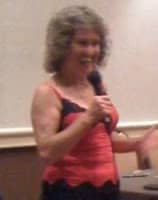
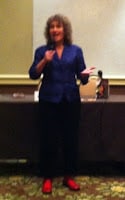 My own session was titled “Senior Sex Out Loud,” the story of my journey from high school English teacher to fitness professional/ health writer to sex educator/ senior sex advocate, with experiences along the way that were sometimes amusing, sometimes amazing, occasionally appalling. I started out wearing a jacket, but shed it when I talked about body acceptance. (Want to hear this speech yourself, or offer one of my workshops at your venue? I have a suitcase packed, would love to come to you. Please email me and let’s talk.)
My own session was titled “Senior Sex Out Loud,” the story of my journey from high school English teacher to fitness professional/ health writer to sex educator/ senior sex advocate, with experiences along the way that were sometimes amusing, sometimes amazing, occasionally appalling. I started out wearing a jacket, but shed it when I talked about body acceptance. (Want to hear this speech yourself, or offer one of my workshops at your venue? I have a suitcase packed, would love to come to you. Please email me and let’s talk.)
But CatalystCon was more than the knowledge, more than the networking, more than the
opportunity for me to share what I do and how I feel about it, more than
learning what other sex educators do and how they feel about it. It
felt like a brave new world was possible, one in which acceptance and
celebration reigned.
Imagine living in a society free of closed-minded people and repressive attitudes and policies, where we celebrate our similarities and our differences and are truly
kind to each other. That was in the air at CatalystCon.
I applaud Dee Dennis, who conceived and birthed CataystCon; the sponsors who made it possible and affordable; the extraordinary speakers who were willing to donate their wisdom and incur their own travel expenses; and the attendees who were eager to absorb new knowledge, communicate openly (even those who wore the “I’m shy” wristbands that Reid gave out), and take our messages home. CatalystConWest will become a yearly event, and CatalystConEast will rock your world March 15-17, 2013 in Washington, DC.
As always, I welcome your comments.

